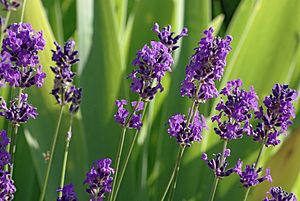Note: This is a project under development. The articles on this wiki are just being initiated and broadly incomplete. You can Help creating new pages.
Lavandula angustifolia - Lavender
Lavandula angustifolia is a flowering plant in the family Lamiaceae and it is native to the Mediterranean regions of Spain, France, Italy, Croatia etc.
Contents
- 1 Uses
- 2 Parts Used
- 3 Chemical Composition
- 4 Common names
- 5 Properties
- 6 Habit
- 7 Identification
- 8 List of Ayurvedic medicine in which the herb is used
- 9 Where to get the saplings
- 10 Mode of Propagation
- 11 How to plant/cultivate
- 12 Commonly seen growing in areas
- 13 Photo Gallery
- 14 References
- 15 External Links
Uses
wounds, burns, headache, typhoid, diphtheria, streptococcus, Pneumococcus, sunburn, scalds, vaginal discharge, anal fissure.
Parts Used
Chemical Composition
Lavender is comprised of over 100 constituents, including linalool, perillyl alcohol, linalyl acetate, camphor, limonene, tannins, triterpenes, coumarins3,4,5, cineole, and flavonoids.[1]
Common names
| Language | Common name |
|---|---|
| Kannada | |
| Hindi | |
| Malayalam | |
| Tamil | |
| Telugu | |
| Marathi | NA |
| Gujarathi | NA |
| Punjabi | NA |
| Kashmiri | NA |
| Sanskrit | |
| English | Agrimony |
Properties
Reference: Dravya - Substance, Rasa - Taste, Guna - Qualities, Veerya - Potency, Vipaka - Post-digesion effect, Karma - Pharmacological activity, Prabhava - Therepeutics.
Dravya
Rasa
Guna
Veerya
Vipaka
Karma
Prabhava
Habit
Identification
Leaf
| Kind | Shape | Feature |
|---|---|---|
| Simple | Lobed or unlobed but not separated into leaflets and Leaf arrangement is opposite |
Flower
| Type | Size | Color and composition | Stamen | More information |
|---|---|---|---|---|
| Unisexual | 2-4cm long | blue to purple | 5 | there is only one way to evenly divide the flower |
Fruit
| Type | Size | Mass | Appearance | Seeds | More information |
|---|---|---|---|---|---|
| general | 7–10 mm | the fruit is dry but does not split open when ripe | many | {{{6}}} |
Other features
List of Ayurvedic medicine in which the herb is used
- Vishatinduka Taila as root juice extract
Where to get the saplings
Mode of Propagation
How to plant/cultivate
Landscape Uses:Alpine garden, Border, Container, Ground cover, Massing, Rock garden, Seashore, Specimen. Succeeds in almost any soil so long as it is well-drained and not too acid[3]
Commonly seen growing in areas
Dry grassy slopes, hot rocky situations, calcareous soils.
Photo Gallery
References
External Links
- Ayurvedic Herbs known to be helpful to treat wounds
- Ayurvedic Herbs known to be helpful to treat burns
- Ayurvedic Herbs known to be helpful to treat headache
- Ayurvedic Herbs known to be helpful to treat typhoid
- Ayurvedic Herbs known to be helpful to treat diphtheria
- Ayurvedic Herbs known to be helpful to treat streptococcus
- Ayurvedic Herbs known to be helpful to treat Pneumococcus
- Ayurvedic Herbs known to be helpful to treat sunburn
- Ayurvedic Herbs known to be helpful to treat scalds
- Ayurvedic Herbs known to be helpful to treat vaginal discharge
- Ayurvedic Herbs known to be helpful to treat anal fissure
- Herbs with Dried Folaige used in medicine
- Herbs with Whole herb used in medicine
- Herbs with common name in English
- Habit - Herb
- Index of Plants which can be propagated by Seeds
- Index of Plants which can be propagated by Cuttings
- Herbs that are commonly seen in the region of Dry grassy slopes
- Herbs that are commonly seen in the region of hot rocky situations
- Herbs that are commonly seen in the region of calcareous soils
- Herbs








